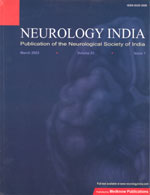
|
Neurology India
Medknow Publications on behalf of the Neurological Society of India
ISSN: 0028-3886
EISSN: 0028-3886
Vol. 52, No. 4, 2004, pp. 478-481
|
 Bioline Code: ni04160
Bioline Code: ni04160
Full paper language: English
Document type: Research Article
Document available free of charge
|
|
|
Neurology India, Vol. 52, No. 4, 2004, pp. 478-481
| en |
Scalp arteriovenous malformations
Shenoy SatyanarayanaN, Raja A
Abstract
AIMS:
We discuss our experience with the surgical management of scalp vascular malformation and review the literature on the subject.
SETTINGS AND DESIGN:
A prospective case-control study of eight patients with scalp vascular malformations admitted to our hospital between 1997 and 2002.
METHODS AND MATERIALS:
All the patients were investigated with selective internal and external carotid angiography. Depending upon the origin of feeding arteries, the scalp vascular malformations were classified into two categories: Group I: the primary scalp arteriovenous malformations and Group II: secondary venous dilatations. Six patients belonged to Group I and two patients were in Group II.
RESULTS:
Five patients belonging to Group I underwent successful excision of the arteriovenous malformation. There was no recurrence in this group. Of the two patients in Group II, one patient who had scalp vascular dilatation simulating a primary scalp vascular malformation underwent excision of the lesion. This patient developed severe postoperative brain edema and died.
CONCLUSIONS:
Primary scalp vascular malformation can be excised safely. However, excision of secondary scalp venous dilatation without treatment of the intracranial component can be dangerous.
Keywords
Scalp, arteriovenous malformation, cirsoid aneurysm
|
| |
© Copyright 2004 Neurology India.
Alternative site location: http://www.neurologyindia.com
|
|
